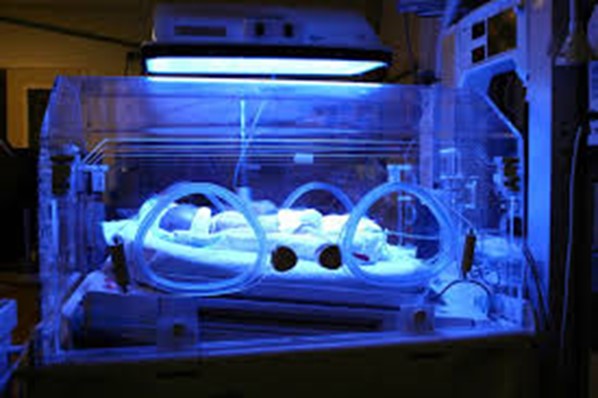The nurse is preparing a 4-day-old infant with a serum bilirubin level of 19 mg/dL (325 µmol/L) for discharge from the hospital. When teaching the parents about home phototherapy, which instruction should the nurse include in the discharge teaching plan?
Total Bilirubin Reference Range: Newborn: 0.1 to 10.5 mg/dL (1.7 to 180 µmol/L)
Feed the infant every 4 hours.
Perform diaper changes under the light.
Reposition the infant every 2 hours.
Cover with a receiving blanket.
The Correct Answer is C
Choice A reason: Feeding the infant every 4 hours is not a specific instruction for home phototherapy, which is a treatment that uses blue light to break down excess bilirubin in the skin and blood. However, feeding the infant frequently is important to promote hydration and elimination of bilirubin through urine and stool.
Choice B reason: Performing diaper changes under the light is not a recommended instruction for home phototherapy, which is a treatment that uses blue light to break down excess bilirubin in the skin and blood. The nurse should instruct the parents to turn off the light and cover the infant's eyes with protective goggles or patches during diaper changes to prevent eye damage or irritation.
Choice D reason: Covering with a receiving blanket is not an appropriate instruction for home phototherapy, which is a treatment that uses blue light to break down excess bilirubin in the skin and blood. The nurse should instruct the parents to keep the infant unclothed except for a diaper and eye protection during phototherapy to maximize skin exposure to the light and increase its effectiveness.

Nursing Test Bank
Naxlex Comprehensive Predictor Exams
Related Questions
Correct Answer is C
Explanation
Choice A reason: Reminding the UAP to apply a fitted respirator mask before entering the client's room is not a necessary action for the nurse to take. A respirator mask is a type of personal protective equipment (PPE. that filters out airborne particles and droplets that may contain infectious agents. A respirator mask is required for clients who have or are suspected of having airborne diseases, such as tuberculosis, measles, or chickenpox. Influenza is a respiratory disease that is transmitted by droplet contact, not by airborne contact.
Choice B reason: Instructing the UAP to notify the nurse of any changes in the client's respiratory status is not a specific action for the nurse to take. Respiratory status is an assessment of the client's breathing pattern, rate, depth, effort, and oxygen saturation. Respiratory status can be affected by various factors, such as infection, inflammation, obstruction, or injury. The nurse should monitor the client's respiratory status regularly and teach the UAP to report any signs or symptoms of respiratory distress, such as dyspnea, cyanosis, wheezes, or cough.
Choice D reason: Assigning the UAP to provide care for another client and assuming full care of the client is not a feasible action for the nurse to take. The nurse should delegate tasks according to the scope of practice, competency, and availability of staff. The nurse should not reassign staff without a valid reason or without consulting with other team members. The nurse should also not assume full care of a client unless it is necessary or appropriate. The nurse should supervise and evaluate the UAP's performance and provide feedback and guidance.
Correct Answer is ["B","C","E","F"]
Explanation
Choice B is correct because weight management is an important factor in preventing and controlling hypertension. Taking daily walks for thirty minutes can help reduce weight and lower blood pressure.
Choice C is correct because salt substitutes can help with maintaining a healthy diet by reducing sodium intake. Sodium intake is associated with increased blood pressure and should be limited to less than 2,300 mg per day.
Choice E is correct because sodium intake can be regulated by rinsing canned foods in water. Canned foods often contain high amounts of sodium as a preservative and rinsing them can remove some of the excess sodium.
Choice F is correct because uncontrolled hypertension can lead to renal damage. Hypertension can cause damage to the blood vessels and impair the function of the kidneys, leading to chronic kidney disease or failure.
Choice A is incorrect because alcohol consumption can produce vascular changes that increase blood pressure. Alcohol intake should be limited to no more than one drink per day for women and two drinks per day for men.
Choice D is incorrect because blood pressure readings should not be taken at noontime. Blood pressure readings should be taken at the same time each day, preferably in the morning before breakfast or in the evening before dinner.
Whether you are a student looking to ace your exams or a practicing nurse seeking to enhance your expertise , our nursing education contents will empower you with the confidence and competence to make a difference in the lives of patients and become a respected leader in the healthcare field.
Visit Naxlex, invest in your future and unlock endless possibilities with our unparalleled nursing education contents today
Report Wrong Answer on the Current Question
Do you disagree with the answer? If yes, what is your expected answer? Explain.
Kindly be descriptive with the issue you are facing.
